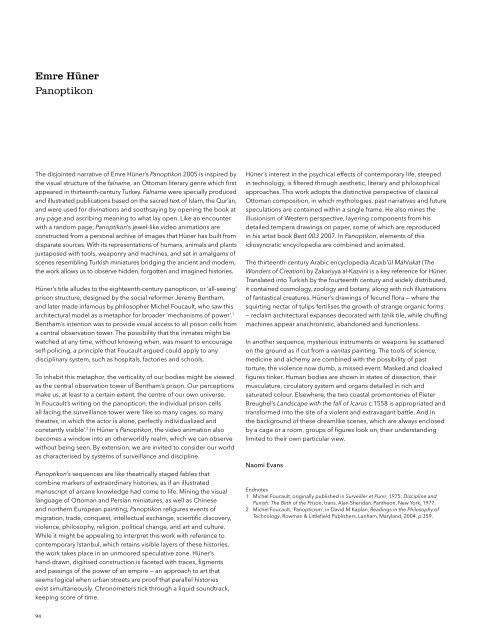Queensland Art Gallery - Queensland Government
Queensland Art Gallery - Queensland Government
Queensland Art Gallery - Queensland Government
You also want an ePaper? Increase the reach of your titles
YUMPU automatically turns print PDFs into web optimized ePapers that Google loves.
Emre Hüner<br />
Panoptikon<br />
The disjointed narrative of Emre Hüner’s Panoptikon 2005 is inspired by<br />
the visual structure of the falname, an Ottoman literary genre which first<br />
appeared in thirteenth-century Turkey. Falname were specially produced<br />
and illustrated publications based on the sacred text of Islam, the Qur’an,<br />
and were used for divinations and soothsaying by opening the book at<br />
any page and ascribing meaning to what lay open. Like an encounter<br />
with a random page, Panoptikon’s jewel-like video animations are<br />
constructed from a personal archive of images that Hüner has built from<br />
disparate sources. With its representations of humans, animals and plants<br />
juxtaposed with tools, weaponry and machines, and set in amalgams of<br />
scenes resembling Turkish miniatures bridging the ancient and modern,<br />
the work allows us to observe hidden, forgotten and imagined histories.<br />
Hüner’s title alludes to the eighteenth-century panopticon, or ‘all-seeing’<br />
prison structure, designed by the social reformer Jeremy Bentham,<br />
and later made infamous by philosopher Michel Foucault, who saw this<br />
architectural model as a metaphor for broader ‘mechanisms of power’. 1<br />
Bentham’s intention was to provide visual access to all prison cells from<br />
a central observation tower. The possibility that the inmates might be<br />
watched at any time, without knowing when, was meant to encourage<br />
self-policing, a principle that Foucault argued could apply to any<br />
disciplinary system, such as hospitals, factories and schools.<br />
To inhabit this metaphor, the verticality of our bodies might be viewed<br />
as the central observation tower of Bentham’s prison. Our perceptions<br />
make us, at least to a certain extent, the centre of our own universe.<br />
In Foucault’s writing on the panopticon, the individual prison cells<br />
all facing the surveillance tower were ‘like so many cages, so many<br />
theatres, in which the actor is alone, perfectly individualized and<br />
constantly visible’. 2 In Hüner’s Panoptikon, the video animation also<br />
becomes a window into an otherworldly realm, which we can observe<br />
without being seen. By extension, we are invited to consider our world<br />
as characterised by systems of surveillance and discipline.<br />
Panoptikon’s sequences are like theatrically staged fables that<br />
combine markers of extraordinary histories, as if an illustrated<br />
manuscript of arcane knowledge had come to life. Mining the visual<br />
language of Ottoman and Persian miniatures, as well as Chinese<br />
and northern European painting, Panoptikon refigures events of<br />
migration, trade, conquest, intellectual exchange, scientific discovery,<br />
violence, philosophy, religion, political change, and art and culture.<br />
While it might be appealing to interpret this work with reference to<br />
contemporary Istanbul, which retains visible layers of these histories,<br />
the work takes place in an unmoored speculative zone. Hüner’s<br />
hand-drawn, digitised construction is faceted with traces, figments<br />
and passings of the power of an empire — an approach to art that<br />
seems logical when urban streets are proof that parallel histories<br />
exist simultaneously. Chronometers tick through a liquid soundtrack,<br />
keeping score of time.<br />
Hüner’s interest in the psychical effects of contemporary life, steeped<br />
in technology, is filtered through aesthetic, literary and philosophical<br />
approaches. This work adopts the distinctive perspective of classical<br />
Ottoman composition, in which mythologies, past narratives and future<br />
speculations are contained within a single frame. He also mines the<br />
illusionism of Western perspective, layering components from his<br />
detailed tempera drawings on paper, some of which are reproduced<br />
in his artist book Bent 003 2007. In Panoptikon, elements of this<br />
idiosyncratic encyclopedia are combined and animated.<br />
The thirteenth-century Arabic encyclopedia Acaib’ül Mahlukat (The<br />
Wonders of Creation) by Zakariyya al-Kazvini is a key reference for Hüner.<br />
Translated into Turkish by the fourteenth century and widely distributed,<br />
it contained cosmology, zoology and botany, along with rich illustrations<br />
of fantastical creatures. Hüner’s drawings of fecund flora — where the<br />
squirting nectar of tulips fertilises the growth of strange organic forms<br />
— reclaim architectural expanses decorated with Iznik tile, while chuffing<br />
machines appear anachronistic, abandoned and functionless.<br />
In another sequence, mysterious instruments or weapons lie scattered<br />
on the ground as if cut from a vanitas painting. The tools of science,<br />
medicine and alchemy are combined with the possibility of past<br />
torture, the violence now dumb, a missed event. Masked and cloaked<br />
figures tinker. Human bodies are shown in states of dissection, their<br />
musculature, circulatory system and organs detailed in rich and<br />
saturated colour. Elsewhere, the two coastal promontories of Pieter<br />
Breughel’s Landscape with the fall of Icarus c.1558 is appropriated and<br />
transformed into the site of a violent and extravagant battle. And in<br />
the background of these dreamlike scenes, which are always enclosed<br />
by a cage or a room, groups of figures look on, their understanding<br />
limited to their own particular view.<br />
Naomi Evans<br />
Endnotes<br />
1 Michel Foucault, originally published in Surveiller et Punir, 1975; Discipline and<br />
Punish: The Birth of the Prison, trans. Alan Sheridan, Pantheon, New York, 1977.<br />
2 Michel Foucault, ‘Panopticism’, in David M Kaplan, Readings in the Philosophy of<br />
Technology, Rowman & Littlefield Publishers, Lanham, Maryland, 2004, p.359.<br />
Emre Hüner<br />
Turkey b.1977<br />
Panoptikon (stills) 2005<br />
Digital hand-drawn animation, single channel,<br />
continuous loop, colour, sound, 11:18 minutes, ed. of 5 /<br />
Images courtesy: The artist and Rodeo, Istanbul<br />
94 95
















